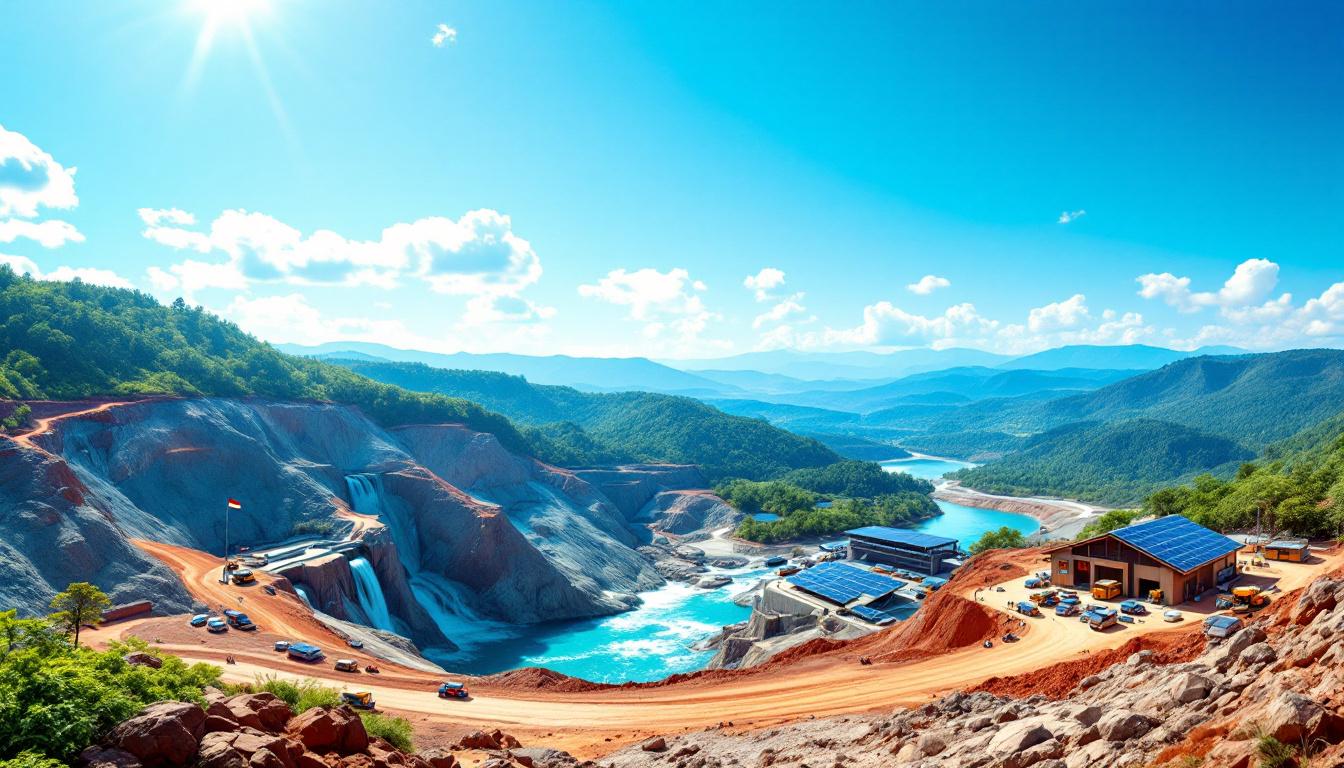India's Copper Supply Challenges: A Growing National Security Issue
India's critical dependence on imported copper has evolved into a major economic vulnerability, with government documents revealing unprecedented strategic measures being considered to secure this essential metal. As global copper supply forecast trends tighten and resource nationalism spreads, India faces mounting pressure to secure stable copper sources for its expanding economy.
India's Growing Copper Dependency
India has developed an alarming reliance on copper imports that threatens its industrial security. According to a 2025 government policy document reviewed by Reuters, "India meets over 90% of its copper concentrate needs through imports, and its dependency is expected to rise to 97% by 2047" without strategic intervention.
The numbers paint a concerning picture:
- Annual refined copper production: approximately 573,000 metric tons
- Annual copper demand: around 1.8 million metric tons
- Import volume: 1.2 million metric tons in fiscal year ending March 2025 (4% year-over-year increase)
This substantial gap between domestic production and demand creates strategic vulnerability, especially as global supply chains face increasing restrictions. The situation deteriorated significantly following the 2018 closure of Vedanta's Sterlite Copper smelter in Tamil Nadu, which removed a major domestic production facility from India's copper equation.
"The closure of the Sterlite plant created an immediate supply shock that continues to reverberate through India's manufacturing sector," notes the government assessment, highlighting how a single facility closure dramatically altered the country's copper security landscape.
Global Copper Market Constraints
India's copper challenges exist within an increasingly constrained global market. The government document explicitly warns that "tightening copper supplies from key exporters such as Indonesia have limited India's sourcing options," creating a perfect storm of supply insecurity.
Several factors are compounding this global constraint:
- Export restrictions: Indonesia and other producers implementing protectionist policies
- Existing commitments: Chile and Peru (major producers) already locked into long-term supply contracts with China
- Resource nationalism: Growing trend among mineral-rich nations to prioritize domestic processing and value capture
- Competition intensification: More nations pursuing similar mineral security strategies
This "resource nationalism" trend mirrors China's April 2025 rare earth export restrictions, which served as a wake-up call for mineral-dependent economies worldwide. For India, this evolving landscape necessitates urgent action to prevent future supply disruptions.
India's Strategic Response Plan
India has initiated internal discussions about its growing vulnerability to the tightening global market, according to government sources familiar with the matter. These discussions have produced multiple strategic approaches aimed at securing both immediate and long-term copper price forecasts that remain favorable to India's economic interests.
International Partnership Strategies
The government is developing a multi-pronged approach to international partnerships:
- Dedicated "copper chapters" in free trade negotiations with Chile and Peru, explicitly designed to secure concentrate supplies
- Direct outreach to global mining majors including Chile's state-owned Codelco (the world's largest copper producer) and Australian mining giant BHP
- Reciprocal investment model where Indian state firms invest in overseas mining projects in exchange for commitments to develop copper infrastructure in India
This approach represents a significant shift toward resource diplomacy as a component of India's economic security strategy.
Domestic Production Enhancement
Beyond securing imports, India is developing plans to boost domestic refined copper output through several mechanisms:
- Exploring foreign investment opportunities in domestic copper processing
- Potential development of new copper smelters and refineries with international expertise
- Incentive structures to encourage private sector participation in copper production
"India could approach global majors such as Chile's state-owned miner Codelco and Australian miner BHP to set up domestic smelters and refineries," revealed a senior government official who requested anonymity due to the sensitive nature of these discussions.
The Role of State Enterprises in India's Copper Strategy
India's copper security strategy heavily leverages state-owned enterprises as instruments of national policy. The government has specifically targeted Khanij Bidesh India Ltd (KABIL) as the spearhead for its international copper acquisition efforts.
Khanij Bidesh India Ltd's Expanded Mission
According to the government document, KABIL has been directed to:
- Secure supplies of strategic minerals from overseas sources
- Actively explore copper assets in resource-rich countries including Chile, Peru, Australia, and Mongolia
- Develop partnerships with foreign mining entities to ensure consistent supply
This expanded mandate positions KABIL as the operational arm of India's mineral security strategy, mirroring approaches taken by countries like China and Japan with their state-backed resource acquisition entities.
Strategic Resource Acquisition
The government document emphasizes that recent trends in resource nationalism "underscore an urgency for foreign asset acquisition." This urgency is driving a more aggressive approach to securing overseas mining assets before global competition further limits available opportunities.
The policy explicitly draws parallels to China's rare earth export restrictions implemented in April 2025, suggesting India must develop similar resource control mechanisms to protect its industrial interests. By acquiring foreign copper assets, India aims to bypass potential future export restrictions from producing nations.
The Critical Importance of Copper Security for India's Future
Copper's role in India's economic security extends far beyond simple supply chains. As an essential input for manufacturing, construction, infrastructure development, and the green energy transition, copper represents a keystone mineral for India's development trajectory.
Economic and Industrial Implications
The government document highlights that India's massive copper demand reflects its position as one of the world's fastest-growing major economies. Supply disruptions would impact:
- Electronics manufacturing
- Electrical equipment production
- Infrastructure development
- Construction
- Renewable energy projects
- Electric vehicle production
With annual demand of 1.8 million metric tons projected to grow substantially, securing stable copper supplies directly impacts India's ability to maintain industrial growth and meet its infrastructure development goals.
Global Competition for Resources
India's copper security efforts take place against a backdrop of intensifying global competition for critical minerals. The policy document notes that "Chile and Peru already have long-term commitments with major global buyers like China, further narrowing India's import choices."
This observation highlights a critical challenge: India must compete for limited copper resources against nations with established relationships and potentially greater purchasing power. Furthermore, the Codelco copper strategy with Japan demonstrates how major producers are forming strategic alliances that could further limit India's options.
Implementation Challenges
Despite clear strategic imperatives, India faces significant hurdles in implementing its copper security strategy.
Market Access Barriers
The government document explicitly identifies several market barriers:
- Limited sourcing options due to export restrictions from key suppliers like Indonesia
- Chile and Peru's existing long-term commitments to China and other buyers
- Growing "resource nationalism" among mineral-rich countries
- Competition with other copper-hungry economies
These barriers suggest India will likely pay premium prices to secure long-term supply agreements, particularly when approaching established producers with existing customer relationships.
Domestic Development Hurdles
While not explicitly detailed in the government document, India's plans to boost domestic refined copper output face several implied challenges:
- Environmental and regulatory frameworks for new smelting operations
- Capital requirements for developing domestic capacity
- Technical expertise gaps in advanced copper processing
- Balancing economic development with environmental considerations
The closure of Vedanta's Sterlite Copper smelter in 2018 due to environmental concerns serves as a cautionary example of how these factors can impact domestic production capacity.
Strategic Copper Security: A Critical Path Forward
India's copper strategy represents a comprehensive response to a growing national security concern. As a comprehensive report by the IISD emphasizes, the combination of rising demand, tightening global supplies, and increasing resource nationalism creates an urgent imperative for action.
The government's multi-pronged approach – securing overseas supplies, developing domestic capacity, leveraging state enterprises, and incorporating copper security into trade negotiations – reflects the complexity of the challenge and the seriousness with which India is addressing India and copper supply risks.
For India's manufacturing sector, infrastructure development plans, and green energy transition, the success of this copper security strategy may determine whether the country can maintain its industrial growth trajectory or faces supply constraints that limit its economic potential.
As US copper production and international copper investments continue to evolve globally, India's proactive approach to copper security may serve as a model for how developing economies can protect their resource interests in an increasingly resource-nationalist world.
Want to Capitalise on the Next Major Copper Discovery?
Stay ahead of the market with Discovery Alert's proprietary Discovery IQ model, which instantly notifies you of significant ASX mineral discoveries, including copper. Explore why major mineral discoveries can lead to substantial returns by visiting our dedicated discoveries page, and begin your 30-day free trial today.




